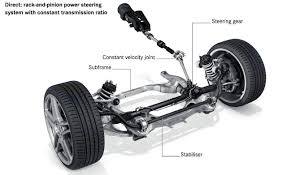The front wheels are
turned to the right or left as per the will of the driver through the
mechanical advantage of the steering gear and the linkage
There are some disadvantages in manual
steering.
v
It
is bigger and heavier in engines on cars.
v
Low
pressure types should be used in case of cars.
v
The
larger steering ratio is required to steer these cars. For this, more turns of
the steering wheel are required to move to the desired distance.
v
Larger
tyres having heavier weight on vehicles make the car more difficult in parking.
So, the driver has to apply greater physical strength for driving the vehicles.
v
To
overcome this difficulty, power – assisted steering has been introduced as
shown in fig. They have only power
–assisted steering, called power steering.
When a car is steered manually, the
driver has to supply all the
WORKING
v
The
power steering is to improve driving comfort, most modern automobiles have
wide, low pressure tyres with increased the tyre to road surface contact area.
v
The
power – steering system used in automobiles is actually a modified manual –
steering system as show in fig.
v
The
steering column, steering gear, and steering linkage entirely vary from the
manual – steering systems. The main difference between power steering and
manual steering system is a power booster attached to assist the driver.
v
In
this power – assisted steering, the booster is operated when the steering shaft
turns. When the steering effort exceeds a certain force, when the steering
wheel turns, valves are actuated by this hydraulic pressure to a cylinder.
“Then this pressure makes the piston to move and provides most of the steering
force.
A simple
hydraulic power assisted steering is illustrated in fig
v
It
consists of a fluid reservoir, hydraulic pump, hydraulic ram, control valve,
steering shaft, steering box and steering wheel.
v
The
engine driven by hydraulic pumps supply oil under pressure from the oil
reservoir to the feed lines. A hydraulic control valve provided below the
steering measures the input pressure at the steering wheel. Then the pressure
is converted in to the hydraulic ram.
v
When
the steering wheel is stationary, the oil will exert the same pressure on both
sides of the piston and retain the piston at rest.
v
When
the driver turns the steering wheel, the control valve is moved by the steering
arm. At that time, one of the ports closes while the other one opens.
v
High
pressure oil enters one side thereby moving the piston. Then this movement of
the piston actuates the steering linkage to move in the required direction.
v
This
system is used in big cars and heavy commercial vehicles.
v
It
is very much suitable for low speeds and the vehicle for parking purposes while
reversing.






No comments:
Post a Comment